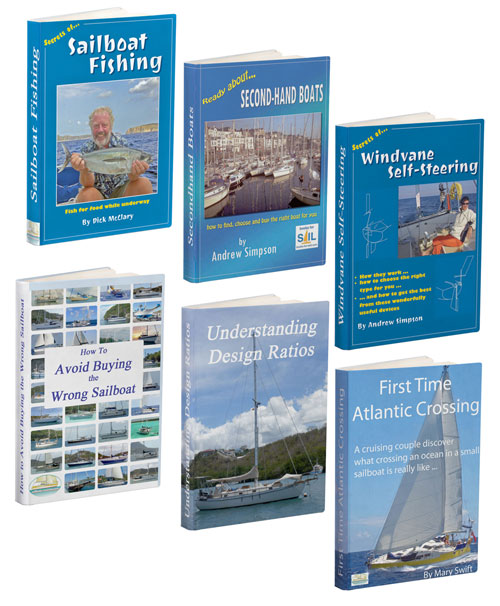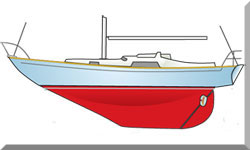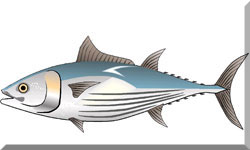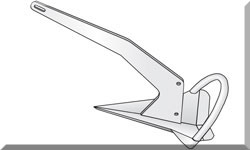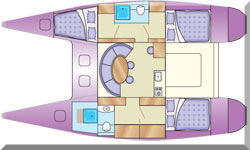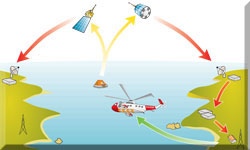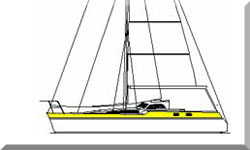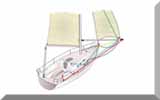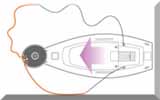- Home
- Offshore Seamanship and Heavy Weather Tactics
- Wind Vanes and Electronic Autopilots
Self-Steering on Passage: Guide to Wind Vanes & Electronic Autopilots
In a Nutshell...
For serious offshore sailing, a mechanical Wind Vanes & Electronic Autopilots approach offers the ultimate blend of reliability and redundancy. A windvane self-steering gear is the low-power champion, tirelessly steering to the apparent wind for days on end without drawing a single amp—it's ideal for long passages.
Electronic autopilots, while power-hungry and more complex, offer precise steering to a compass heading or a GPS route, making them indispensable for motoring or in light, confused airs.
The consensus among experienced ocean sailors? You really should have both. A vane gear for when you're sailing, and an autopilot for when you're under power. That way, you've got a bomb-proof backup system for any scenario.
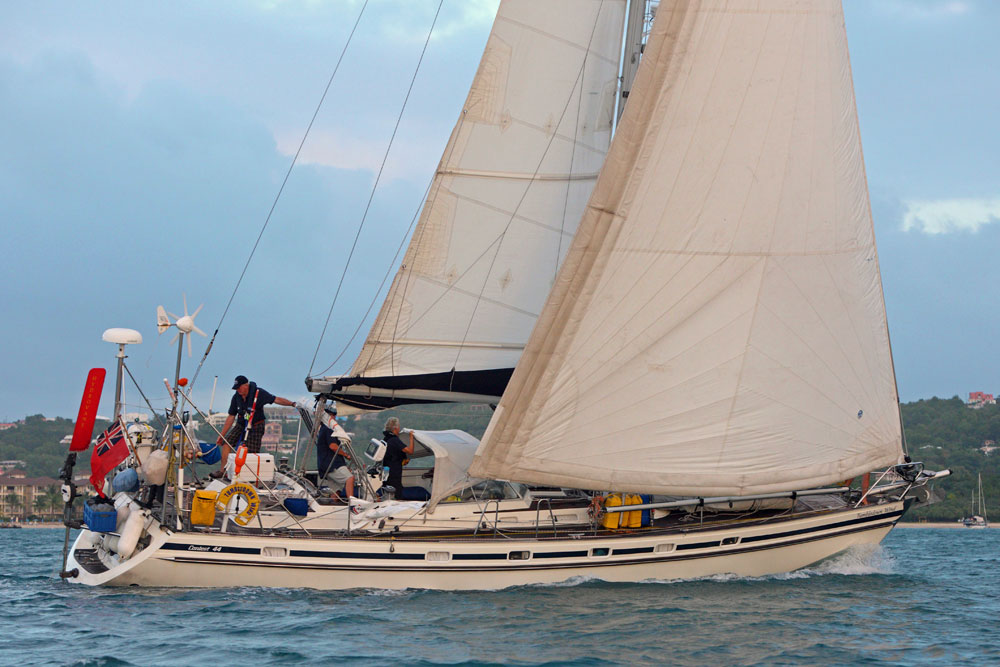 The Hydrovane wnd-vane self-steering gear on this Contest 44 has just brought her safely across the Atlantic Ocean
The Hydrovane wnd-vane self-steering gear on this Contest 44 has just brought her safely across the Atlantic OceanTable of Contents
- Windvane Self Steering & Electronic Autopilots: A Practical Comparison
- The Ingenuity of Windvane Gear: How it Works
- Types of Windvane Gears for Blue Water Sailing
- Electronic Autopilots: The Thirsty Beast
- Linking a Tiller Pilot & a Vane Gear (The Perfect Marriage)
- Operational Tactics & Performance Tuning
- Beyond Failure: Emergency Backup & Redundancy
- Installation, Maintenance & Ownership Philosophy
- Summing Up
- Frequently Asked Questions (FAQs)
Windvane Self Steering & Electronic Autopilots: A Practical Comparison
For years, the unmistakable profile of a windvane self-steering gear bolted to the transom was the mark of a true offshore sailboat. It was a badge of honour, separating the coastal cruiser from the passage maker. Today, the lines are blurred. Modern, compact electronic autopilots are slick, incredibly powerful, and ubiquitous. Yet, I'd argue that the sailors who've hitched the vane gear entirely for the convenience of power-hungry electronics are potentially missing a trick—they're sacrificing genuine reliability for convenience.
There's simply nothing that compares to a good vane gear when you’re on a long blue-water passage. If there's enough breeze to fill the sails, that mechanical wizardry will steer your boat for hours without demanding so much as a single amp. It's a non-negotiable component of a robust offshore setup, partnering perfectly with the electronic autopilot, which is, admittedly, essential when the engine's running or you need precise GPS-based steering.
Offshore self-steering isn't a one-size-fits-all solution. The choice depends entirely on your situation—are you motoring up a channel, or are you crossing an ocean? This table breaks down how the two core technologies stack up against each other from a sailor's perspective.
| Feature | Windvane Self-Steering Gear | Electronic Autopilots |
|---|---|---|
| Power Consumption | Zero. Entirely mechanical. | Significant. Can deplete battery banks rapidly. |
| Steering Basis | Steers to the apparent wind angle. | Steers to a compass heading or GPS waypoint. |
| Performance Under Sail | Excellent. Continually adjusts course as wind shifts, maintaining efficient sail trim. | Good, but often results in a jagged course as it chases a magnetic heading, requiring more constant sail trimming. |
| Performance Under Power | Completely ineffective & shouldn't be engaged. | Excellent. Essential for motoring. |
| Reliability & Repair | Mechanically robust, easily maintained, and repairable with basic spares & tools. | Can be complex, susceptible to electronic failure, and difficult to repair mid-ocean. |
| Initial Cost | High (often comparable to a mid-range electronic system). | Variable (from basic tiller pilots to high-end hydraulic systems). |
The Ingenuity of Windvane Gear: How it Works
A windvane gear is essentially a sophisticated mechanical brain. These entirely non-electric devices work by sensing the apparent wind direction and then translating that small impulse into a powerful steering action that controls the boat's rudder, keeping the vessel on a course relative to the wind.
Sensing the Apparent Wind
The key to a windvane's operation is its reliance on apparent wind. As seasoned sailors, we know the apparent wind is what we actually feel on deck—a combination of the true wind and the wind generated by the boat’s motion.
The windvane, which acts just like a masthead wind indicator, aligns itself with the apparent wind. When the boat wanders off the desired course (relative to the wind), the angle of the wind hitting the vane changes. This deflection generates the small, initial steering impulse.
This dynamic response is its greatest strength. If the true wind veers or gusts, the apparent wind shifts, and the boat's heading is immediately adjusted to maintain the same angle to the wind. Because the sails are already trimmed for that apparent wind angle, the boat continues to sail efficiently, as if an expert helmsman were continually making subtle adjustments.
 The wind you feel..
The wind you feel..The Windvane & The Linkage
The vane itself is where the magic starts. It needs to be light, strong, and precisely cut to the manufacturer’s design, often made from marine ply, plastic, or even fabric stretched over a frame. Vanes are categorised by their axis of rotation:
Vertical Axis Vanes

These pivot like a weathercock. They always point into the wind, and the area responding to a change in course is relatively small.
The corrective steering energy they generate is minor, making them less powerful for larger or heavier boats.
A counterbalance ensures they aren't simply deflected by the boat's heel.
Horizontal Axis Vanes
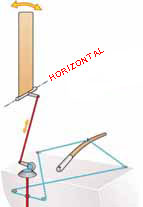
Here's the thing: these are the powerhouses. They're inclined, typically around 20°, and are counterbalanced to stand upright in a no-wind situation.
When the boat deviates from course, the wind strikes the vane, tilting it over and exposing its entire face to the force of the wind.
That significantly larger effective area generates far more leverage—up to five times more efficient than the vertical axis type.
The angle of incline actually helps to dampen the power as the vane is pushed over, giving you a more sensitive and less violent steering effect.
Translating Impulse to Power
A tiny deflection on the vane needs to be translated into enough force to turn a main rudder, often weighing many kilograms. This is achieved using a servo effect:

1. Trim Tab: A small tab is fitted to the trailing edge of the main rudder blade.
The windvane changes the angle of this tab.
The flow of water acting on the small tab then generates enough force to push the main rudder over.
You could say the tab steers the rudder, and the rudder steers the boat.
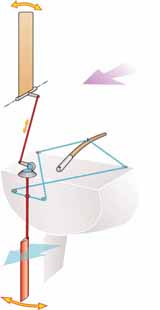
2. Servo-Pendulum: Far more powerful, this system uses the windvane to turn a high-aspect ratio blade (the pendulum) submerged in the water.
As the boat moves, the water flow acts on this blade, sweeping it powerfully to one side.
The power generated by a servo-pendulum at speed is genuinely impressive.

Early windvane self steering gears - particularly the super powerful pendulum servo gears - could be quite violent in their actions.
These days, manufacturers use clever feedback mechanisms within the linkage geometry—such as having the trim tab pivot point slightly astern of the rudder's axis—to progressively reduce the corrective effect as the rudder turns.
This damps the steering, stopping the system from over-correcting and violently slinging the helm over.
Types of Windvane Gears for Blue Water Sailing
The best type of windvane depends heavily on your boat's size, rudder setup, and steering mechanism (tiller or wheel).
1. Servo-Pendulum Acting on Main Rudder
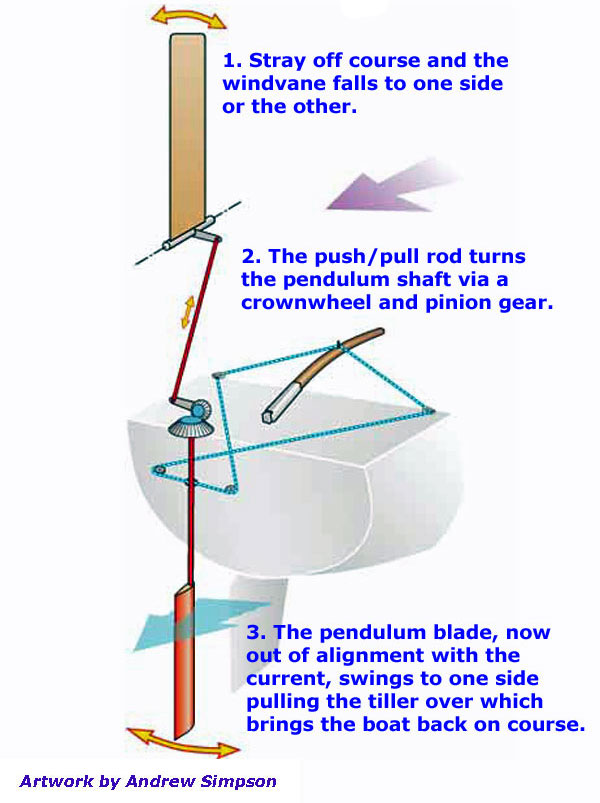
- Examples: Monitor, Aries.
- Mechanism: Horizontal axis vane drives a powerful servo-pendulum blade in the water. Lines are led back to the main helm (tiller or wheel).
- Pros: Most powerful and responsive type. Steering forces scale with wind speed and boat speed. It works directly on the vessel's primary steering system.
- Cons: Steering lines can clutter the cockpit. Less suited for centre-cockpit arrangements due to the line runs.
2. Direct Action with Auxiliary Rudder
- Example: Hydrovane.
- Mechanism: It's a self-contained unit with a vertical axis vane that directly operates its own small, auxiliary rudder, entirely separate from the main rudder. You usually lash the main rudder amidships.
- Pros: No lines in the cockpit. Can be used as a fully independent emergency steering system should the main rudder fail—a massive advantage offshore. Great alternative for centre-cockpit boats.
- Cons: Less steering power than the servo-pendulum types, particularly in heavy weather. Permanent installation that affects steering when going astern under power.
3. Auxiliary Rudder with Servo Pendulum/Tab
- Mechanism: The vane drives a servo blade or trim tab, which in turn steers a separate auxiliary rudder.
- Pros: No cockpit lines. Offers a good balance of power and convenience for complex steering setups (like hydraulic).
- Cons: The auxiliary rudder is typically smaller and may not have sufficient power to recover the boat quickly from a severe knock-down or violent course deviation in a gale.
My personal preference, as a seasoned ocean sailor, leans towards the servo-pendulum systems like the Monitor or Aries. Their sheer power and responsiveness in all but the lightest airs are unparalleled, and they feel like a true extension of the boat. However, the Hydrovane’s ability to act as a stand-alone emergency rudder offers a compelling safety argument that's hard to ignore.
Electronic Autopilots: The Thirsty Beast
A sailboat autopilot is a thirsty beast, drinking your battery juice as if its life depended on it—which of course it does. Providing your boat's batteries can keep up with its electrical appetite, an autopilot deserves a place on any sailboat, large or small.
Cockpit Autopilots: Tiller & Wheel Versions
Cockpit versions of autopilots are the most common solution for cruising boats, relying on fluxgate compasses to keep them on the straight and narrow.
Tiller Pilots for Tiller-Steered Sailboats
Autopilots for tiller steered vessels—or 'tillerpilots' as they are widely known—are the simplest form, in which an electric motor is connected via a transmission mechanism directly to a push rod. Small tiller-pilots, suitable for boats up to around 4,500kg displacement, consist of a single module which includes the compass, the control unit, the motor and push rod.
- Popular Models: Raymarine's ST1000+ (up to 3,000 kg), ST2000+ (up to 4,500 kg), and the modern EV-100 Tiller (up to 6,000 kg). Simrad offers the TP10, TP22, and the more powerful TP32.
- Key Consideration: It's crucial to check your boat's fully laden displacement and choose a model with a thrust rating that comfortably exceeds this figure.
Wheel Pilots for Wheel-Steered Sailboats
Autopilots for wheel steered vessels are very similar to the tiller version, except that course corrections are applied to the wheel by a belt, rather than a pushrod.
- Popular Models: Raymarine's EV-100 Wheel Pilot (up to 7,500 kg) and the Cockpit MkII Wheel Drive. Garmin offers the Reactor 40 with a Wheel Drive unit, known for its responsive 9-axis sensor technology.
- Key Consideration: These systems require a robust drive unit that can handle the loads, often using a clutch mechanism for easy switching between autopilot and manual steering.
Inboard & Integrated Systems
Powerful and fully integrated with onboard navigation systems, inboard autopilots are designed for larger sailing yachts. Instead of connecting to the wheel or tiller, they operate via push rods or hydraulic systems linked directly to the rudder post or quadrant.
- System Integration: The modern trend is towards integration. By connecting to compatible GPS and wind instruments, these systems offer three main operating modes: Auto (locks onto a heading), Track (follows a GPS route), and Wind Vane (maintains a course relative to the apparent wind).
- Specialised Requirements: For sailors operating Multihulls, be aware that the unique motion, speed, and dual-rudder setups of catamarans and trimarans demand specialised, high-response systems. We cover these specific requirements in detail in our dedicated article: Multihull Autopilots: They're Not Your Average Electronic Helmsman.
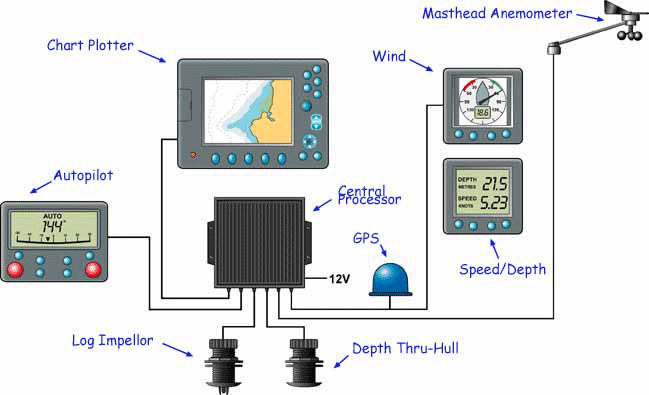 A typical integrated instrument system
A typical integrated instrument systemFeeding the Beast: Power Consumption & Management
Power consumption of an electronic sailboat autopilot can be significant. Your charging system needs to be robust; any weakness, and the autopilot will soon expose it. The key factors affecting its electrical appetite are:
- Sail trim: Poorly trimmed sails and excessive weather helm force the pilot to constantly fight the helm.
- Sea state: Bigger seas and increased yawing require more frequent steering adjustments and higher current spikes.
- Autopilot setting: The more precise the course setting, the greater the work to be done by the autopilot.
- Boat displacement and waterline length: The more boat there is to move, the greater the motor has to work.
- Underwater shape: A keel-mounted rudder will require more force because it's impossible to balance, whereas a fully balanced spade rudder will be lightest on the helm.
Linking a Tiller Pilot & a Vane Gear (The Perfect Marriage)
Here's a clever trick for conserving power: By removing the windvane from a vane-gear and connecting a small tiller autopilot in its place, you can now use a vane-gear when under power. The pendulum or trim-tab now works with the autopilot, greatly reducing power consumption because the autopilot is only providing the tiny, low-force input to the vane mechanism, not wrestling the main rudder.
Some windvane gears, like the Auto-Helm and the Windpilot Pacifics for example, are constructed with this in mind and have the connection fitting built in.
Operational Tactics & Performance Tuning
Getting the most out of either system requires more than installation; it demands tuning and thoughtful daily operation.
Practical Tuning for Optimal Performance
- Vane Tuning: Light vs. Heavy Air: The power of a windvane is proportional to the size of the vane and the speed of the apparent wind. Experienced sailors carry a range of spare vanes in different sizes. Using a larger, lighter vane in light air maximises the impulse, while switching to a smaller, heavier vane in a gale reduces over-steering and violence, often dramatically improving performance.
- Autopilot Tuning: Rudder Gain: This is the most critical setting. Rudder Gain determines how aggressively the pilot moves the rudder in response to course deviation. Adjusting gain is vital for balancing precision and power draw (low gain for efficiency, high gain for precision in rough seas).
Mid-Passage Operational Tactics
- Assisted Tacks & Gybes: Don't fight the vane gear when changing tack. Adjust the vane's course line slightly before the manoeuvre to initiate the turn. This pre-load on the system reduces the effort needed on the main helm.
- Sail Selection Interaction: Systems perform best when the boat is well-balanced. When running downwind in a swell, the use of a poled-out headsail or running twin-headsails can vastly reduce the yawing tendency, allowing both the windvane and autopilot to steer with minimal input and greater efficiency.
Beyond Failure: Emergency Backup & Redundancy
A robust offshore vessel requires a steering plan that accounts for the failure of the primary systems. Redundancy means having not just a backup, but a backup for the backup.
The Third Line of Defence: Electronic Backup
Even if you have a powerful below-deck autopilot, carrying a simple, compact tiller-pilot is smart seamanship. These small units can be easily connected to an emergency tiller on a wheel-steered boat or directly to a standard tiller.
- Benefits: Low-cost, relatively low amp-draw compared to main systems, and completely independent electronics and drive. It gives you another small measure of self-steering capability when the main pilot fails.
Jury Rigging Steering
In the catastrophic event that the main rudder is damaged (a collision or structural failure) and you don't have an auxiliary rudder type vane gear, you must be prepared to jury-rig a steering solution.
- Drogue Steering: Deploying a drogue or a series of warps/buckets off the stern can help drag the boat into a stable course relative to the waves, offering some measure of steerage.
- Storm Sail & Trim: In heavy weather, steering can sometimes be achieved entirely by adjusting the sheet tension and trim of a small storm jib or storm trysail—a necessary skill for any experienced ocean sailor. This relies on the boat naturally wanting to round up, which you then control with sail-induced drag.
The core principles of having redundant systems, whether for steering or power, underpin all aspects of sailing preparation. For a complete guide to preparing yourself and your vessel for the demands of long distance cruising, be sure to visit our Mastering Offshore Seamanship & Safety page.
Installation, Maintenance & Ownership Philosophy
A self-steering system is only reliable if it's correctly fitted and maintained.
Routine Maintenance
- Vane Gear Spares: Your spares kit must include shear pins (if applicable), pre-cut spare vanes, and sufficient steering line to replace the runs in the cockpit. Carry spare line blocks if your setup uses them.
- Autopilot Spares: Critical spares include drive motor brushes for DC systems, a spare clutch assembly or drive belt (if applicable), and fuses. Electronic parts rarely survive a repair mid-ocean, so focus on the mechanical drive components.
- Corrosion Management: Regularly check the sacrificial anode on any water-immersed metal component (pendulum blades, auxiliary rudders, rudder shafts). Anti-fouling is essential to prevent marine growth, which instantly degrades the hydrodynamic efficiency of the steering blade.
Installation & Alignment
- Location is Key: The unit must be mounted centrally on the transom and as vertically as possible to ensure symmetrical steering. Any significant offset will result in helm bias and poor performance on one tack.
- Clearance: Ensure the vane and pendulum blade have adequate clearance from the boat's rudder, engine exhaust, and stern gear.
- Steering Lines: For servo-pendulum gears, the line runs must be kept as friction-free as possible. Use quality blocks and ensure the line entry/exit points to the helm are direct and clean. Excessive friction will dramatically reduce the system's effectiveness.
Troubleshooting Steering Issues
| Symptom | Probable Cause | Sailor’s Fix |
|---|---|---|
| Vane Hunting Violently | Too much power for the conditions & not enough feedback. | Swap to a smaller vane. If possible, increase linkage damping or check if the vane axis is correctly inclined. |
| Poor Performance in Light Airs | Vane too heavy, excessive friction, or insufficient boat speed. | Swap to a larger, lighter vane. Check & clean all linkages. Trim sails aggressively—the vane needs boat speed to generate power. |
| Electronic Pilot is Sloppy/Over-steering | Rudder Gain is too low (sloppy) or too high (over-steering). | Adjust the Rudder Gain setting down in calm seas for efficiency, or up slightly in rough seas for precision. Check for drag on the rudder post. |
| Steering Fine on One Tack, Poor on the Other | Helm bias in the boat or misalignment of the vane gear. | Try a slight adjustment to the main rudder trim. If persistent, the vane gear may need re-centralising or the vertical alignment checked. |
Summing Up
The debate between windvane self-steering gear and electronic autopilots isn't really a debate at all for the serious offshore sailor—it's a choice between primary and secondary systems. The mechanical vane gear is the trustworthy, zero-power workhorse, tirelessly guiding the boat across oceans with a sensitivity to the wind that no electronic system can truly replicate.
The autopilot, in contrast, is the precise, short-term expert, essential for motoring, entering port, or navigating complex GPS routes. By embracing the reliability of the former and the convenience of the latter, and by ensuring you have robust power and tertiary backup solutions, you ensure you have the necessary redundancy to handle any eventuality, from a failed battery bank to a calm motor-sail. This dual-system approach is the gold standard for genuinely safe and efficient blue-water passage making.
This article was written by Dick McClary, RYA Yachtmaster and author of the RYA publications 'Offshore Sailing' and 'Fishing Afloat', member of The Yachting Journalists Association (YJA), and erstwhile member of the Ocean Cruising Club (OCC).
Frequently Asked Questions (FAQs)
What is the main drawback of relying solely on an electronic autopilot for offshore sailing?
What is the main drawback of relying solely on an electronic autopilot for offshore sailing?
The main drawback is their significant power consumption and complexity. Electronic autopilots draw substantial current, necessitating large battery banks and robust charging systems. Furthermore, they're susceptible to electronic failure (circuitry, sensors, drive units) that can be difficult or impossible to repair mid-ocean, posing a serious safety risk.
Can a windvane self-steering gear be used as an emergency rudder?
Can a windvane self-steering gear be used as an emergency rudder?
Only the Direct Action with Auxiliary Rudder type, such as the Hydrovane, can be used as a fully functional, independent emergency rudder. The main rudder is lashed, and the auxiliary rudder on the vane gear takes over steering duties. Servo-pendulum types act on the main rudder and can't steer the boat if the main rudder or steering linkage fails.
Do windvane gears work with hydraulic steering systems?
Do windvane gears work with hydraulic steering systems?
Connecting a servo-pendulum vane gear to a typical hydraulic steering system can be very difficult because the ram and fluid resist the forces transmitted through the steering lines. For boats with hydraulic steering, the Auxiliary Rudder type (either direct action or servo tab) is generally the better and more reliable alternative as it operates entirely independently of the main helm.
Why do windvane gears steer to the apparent wind and not the magnetic course?
Why do windvane gears steer to the apparent wind and not the magnetic course?
Windvane gears are purely mechanical devices that use the force of the wind on the vane to create their steering impulse. By steering to the apparent wind, the gear ensures the sails maintain a constant angle to the airflow, keeping the rig efficiently powered even when the wind shifts. While this results in a varying magnetic course, it's the most efficient way to sail over long distances.
Is the extra weight of a windvane on the stern detrimental to a sailboat’s performance?
Is the extra weight of a windvane on the stern detrimental to a sailboat’s performance?
While the weight is a factor, most modern windvanes aren't that heavy. Any small negative effect from the weight is generally offset by the dramatically reduced electrical power consumption (saving weight in batteries/alternators) and the superior, tireless steering quality they provide over long periods, which improves average speed and efficiency compared to manual or electronic steering.
What is the typical daily amp-hour consumption of an electronic autopilot on passage?
What is the typical daily amp-hour consumption of an electronic autopilot on passage?
A typical electronic autopilot consumes between 70 and 170 amp-hours per day (3 to 7 amps hourly), depending on the sea state and sail trim. This significant draw necessitates dedicated charging from solar, wind, or a high-output engine alternator to prevent battery depletion during long non-stop runs.
Resources Used
Yachting Monthly: Guide to Windvane Self Steering Systems
Cruising World: Offshore Autopilot Systems Comparison
Practical Boat Owner: Troubleshooting Vane Gear Performance
Recent Articles
-
Modern Boat Electronics and the Latest Marine Instruments
Dec 20, 25 05:27 PM
Should sailboat instruments be linked to the latest boat electronics as a fully integrated system, or is it best to leave them as independent units? -
Hans Christian 43: Classic Bluewater Cruiser & Liveaboard Sailboat
Dec 10, 25 04:37 AM
Explore the Hans Christian 43: a legendary heavy-displacement, long-keel sailboat. Read our in-depth review of its specs, design ratios, and suitability for offshore cruising and living aboard. -
Planning Your Sailboat Liveaboard Lifestyle: An Ocean Sailor's Guide
Dec 06, 25 05:18 AM
Seasoned sailors share their methodical risk analysis for planning a secure Sailboat Liveaboard Lifestyle, covering financial, property, and relationship risks.
